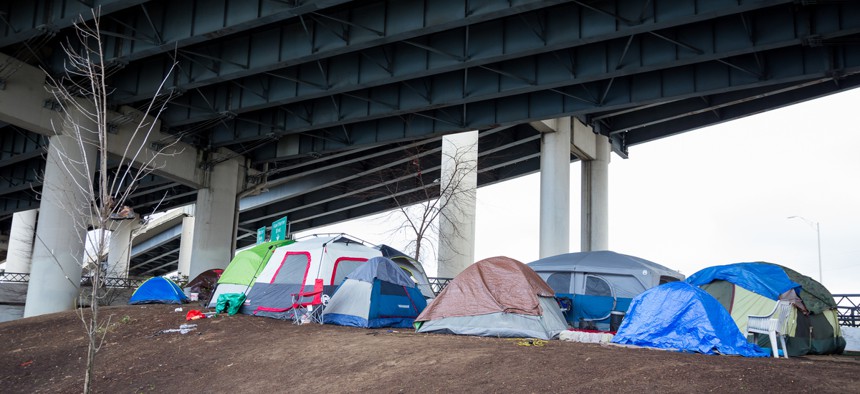Building an Enduring Foundation to Reduce Homelessness

Continuum of Care programs provide services to individuals and families experiencing homelessness Joshua Rainey Photography

Connecting state and local government leaders
COMMENTARY | Communities can improve outcomes for people experiencing homelessness by ensuring they have strong governance for their continuum of care systems.
We’ve all heard the saying, “Rome wasn’t built in a day,” but have you ever sat back and asked yourself, how long did it take to build? What was it built on? How did a small city become a well-organized empire? You’ll have better luck finding these answers in a Roman History class than from me, but, what I have to share about communities stepping up to address homelessness and offer people fresh starts is just as compelling; and grounded in a similar foundation.
While most news reports focus on the growth of people without permanent homes in many cities, there are communities starting to see success. Communities like Allegheny County in Pennsylvania and Montgomery county in Ohio, where concrete steps are being taken to address the underlying, contributing factors of homelessness. These communities’ efforts are leading to increased funding to serve people who are homeless, increased housing availability and redesigned response systems to serve the most vulnerable populations in coordinated, targeted and efficient fashion.
What’s the secret? One important factor is having a strong Continuum of Care (CoC) governance structure. Introduced by the U.S Department of Housing and Urban Development, the CoC Homeless Assistance Program is a community-oriented plan to organize and provide homeless individuals with housing and services. The overarching goal of CoC is to introduce actionable steps local leadership can take toward ending homelessness and preventing a return to homelessness.
Similar (well, sort of) to the pillars of the Colosseum, the four key components of a strong governance structure life cycle are:
- Structure
- Process
- Performance measurement
- Policy
A strong CoC governance structure has clear and concise governing charters, by-laws, and MOUs to guide the work of decision-making authorities to prevent and end homelessness. It also clearly defines the roles and responsibilities of the multiple entities that, together, create the interlocking parts of an effective homeless response system. These entities include the CoC lead agency, also known as the collaborative applicant, the homeless management information system lead, the decision-making bodies, local political leaders and other valuable stakeholders.
Equally important is that a strong structure is one that is built on accountability and follow through, creating internal mechanisms to help guide the process toward transparency and open dialogue.
So why is governance such a big deal? Well, a weak governance structure is like an intense game of Jenga. Once the tower gets so high it loses its foundational strength due to the lack of a strong base. And we all know what happens when you’re the last one that has to remove that block—it all falls apart. A weak governance structure for CoC’s results in loss of investments, setback in developing a data-informed culture, lack of clarity around the community decision-making process and major frustration.
Let’s revisit the earlier examples in Allegheny and Montgomery counties. The Allegheny County CoC has constructed a strong public-private partnership with the Allegheny County Department of Human Services to prevent and end homelessness in Pittsburgh. The community has developed and put in place a strong CoC governance structure to advise the county on their strategies and programmatic funding decisions throughout their neighborhoods. The Homeless Advisory Board includes the Behavioral Health System, the Urban Redevelopment Authority, local law enforcement, local housing authorities and the homeless provider network.
Montgomery County in Ohio is seeing success by taking a similar approach. The community has assembled a network of local stakeholders—both individuals and organizations —which are working together to identify current housing needs, coordinate funding for shelter, develop a system of housing and services, and evaluate progress at the community and program level.
Beyond Allegheny and Montgomery counties, this kind of framework can be applied across communities nationwide. Such a system requires leveraging partners and the broader community through a sub-committee structure to focus on homeless service delivery, data collection and reporting and outreach efforts to work closely with the community’s most vulnerable population. These partnerships work to embrace and execute national best practices and strategic funding decisions in order to deliver a comprehensive response to preventing and ending homelessness.
The bottom line is that communities with strong governance structures, such as Allegheny and Montgomery, stand a better chance of avoiding pitfalls, backslides and the long drawn out periods of frustration. And when pitfalls do occur, they are in a better position to quickly identify and resolve the issue. Just as Rome wasn’t built in a day, your community will need to dedicate time and energy to build a governance structure that can withstand the demands of your homeless response system, mitigate challenges as they arise and produce the desired long-term impact for those most vulnerable.
Michael Lindsay is a technical specialist at ICF, bringing more than 17 years of experience in homeless management information system (HMIS) and CoC implementation. Michael spent a decade working with the Allegheny County Department of Human Services (ACDHS) in Pittsburgh, Pennsylvania, where he administered the Continuum of Care (CoC) and the county's HMIS.

NEXT STORY: When Residents Support Solar—Just ‘Not in My Backyard’




